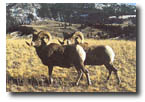%20of%20sheepbar.JPG)
Bighorn Sheep - National Park Service
Bighorn
sheep (Ovis canadensis) once numbered in the millions in western
United States and were an important food source for humans. The "Sheepeaters",
related to the Shoshoni tribe, lived year-round in Yellowstone until
1880. Their principal food was bighorn sheep and they made their bows
from sheep horns. By 1900, during an "epoch of relentless destruction
by the skin hunters" (Seton 1913), bighorn numbers were reduced
to a few hundred in the United States. In 1897 Seton spent several months
roaming the upper ranges of Yellowstone Park and did not see any, although
about 100-150 were estimated to be present. He reported that by 1912,
despite a disease (scab) contracted from domestic sheep, bighorns in
the park had increased to more than 200 and travelers could find them
with fair certainty by devoting a few days to searching around Mt. Everts,
Mt. Washburn or other well-known ranges. In winter, small bands of sheep
could then be seen every day between Mammoth and Gardiner ..."4
great rams with about 40 other sheep...so tame that one could get pictures
within ten feet..."
 Bighorn
sheep are named for the large, curved horns borne by the males, or rams.
Females, or ewes, also have horns, but they are short with only a slight
curvature. Sheep range in color from light brown to grayish or dark,
chocolate brown, with a white rump and lining on the back of all four
legs. Rocky Mountain bighorn females weigh up to 200 pounds, and males
occasionally exceed 300 pounds. During the mating season or "rut",
occurring in November and December, the rams butt heads in apparent
sparring for females. Rams' horns can weigh more than 40 pounds, and
frequently show broken or "broomed" tips from repeated clashes.
Lambs, usually only one per mother, are born in May and June. They graze
on grasses and browse shrubby plants, particularly in fall and winter,
and seek minerals at natural salt licks. Bighorns are well adapted to
climbing steep terrain where they seek cover from predators such as
coyotes, eagles, and mountain lions. They are susceptible to disease
such as lungworm, and sometimes fall off cliffs. Bighorn
sheep are named for the large, curved horns borne by the males, or rams.
Females, or ewes, also have horns, but they are short with only a slight
curvature. Sheep range in color from light brown to grayish or dark,
chocolate brown, with a white rump and lining on the back of all four
legs. Rocky Mountain bighorn females weigh up to 200 pounds, and males
occasionally exceed 300 pounds. During the mating season or "rut",
occurring in November and December, the rams butt heads in apparent
sparring for females. Rams' horns can weigh more than 40 pounds, and
frequently show broken or "broomed" tips from repeated clashes.
Lambs, usually only one per mother, are born in May and June. They graze
on grasses and browse shrubby plants, particularly in fall and winter,
and seek minerals at natural salt licks. Bighorns are well adapted to
climbing steep terrain where they seek cover from predators such as
coyotes, eagles, and mountain lions. They are susceptible to disease
such as lungworm, and sometimes fall off cliffs.
"The Essenstials for
Planning your
Trip to Yellowstone Park" |
|
|
|
|
By 1914 there were about 210 sheep in
Yellowstone and by 1922 there were 300 (Seton 1929). Censuses since
the 1920s have never indicated more than 500 sheep. In recent years,
bighorns have been systematically counted by aerial surveys in early
spring. An annual ground count is also conducted on the winter range
in the northern part of the park.
In the winter of 1981-82, an outbreak
of pinkeye occurred among bighorns in the Mt. Everts area. Many sheep
were blinded and/or killed on the adjacent park road or by falling from
cliffs. No evidence of the disease, a natural occurrence, has been seen
since. Winter visitors to the park still enjoy watching and photographing
bighorns along the cliffs between Gardiner and Mammoth, as they did
80 years ago. Annual surveys of bighorn indicate that the resident herd
on Yellowstone's northern range consists of at least 150-225 animals.
In 1997, a new study done by researchers
at Montana State University began to investigate bighorn population
status and behavior in northern Yellowstone. Of particular interest
to these investigators is the effect of road use on the bighorns' ability
to use their summer and winter range. Sheep are commonly seen along
the road through the Gardner River Canyon, where visitors should be
alert for bighorns crossing between their preferred cliffs and the river
where they drink.
Summering bands are found in the Gallatin
and Washburn Ranges, the Absarokas, and occasionally in the Red Mountains.
On Dunraven Pass, a section of the Grand Loop Road in the park, a band
of ewes and lambs has become somewhat habituated to summer traffic.
These bighorns cause numerous traffic jams and are sometimes illegally
fed by visitors, posing traffic hazards and danger to sheep. Park staff
and visitors are encouraged to educate others about the importance of
the "no feeding" regulation to the long-term welfare of wild
animals.
|

